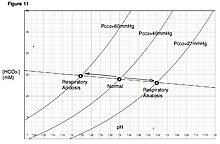Respiratory acidosis
| Respiratory acidosis | |
|---|---|
 | |
| Davenport diagram | |
| Specialty | Intensive care medicine, pulmonology, internal medicine |
Respiratory acidosis is a state in which decreased ventilation (hypoventilation) increases the concentration of carbon dioxide in the blood and decreases the blood's pH (a condition generally called acidosis).
Carbon dioxide is produced continuously as the body's cells respire, and this CO2 will accumulate rapidly if the lungs do not adequately expel it through
Types
Respiratory acidosis can be acute or chronic.
- In acute respiratory acidosis, the PaCO2 is elevated above the upper limit of the reference range (over 6.3 kPa or 45 mm Hg) with an accompanying acidemia (pH <7.35).
- In chronic respiratory acidosis, the PaCO2 is elevated above the upper limit of the reference range, with a normal blood pH (7.35 to 7.45) or near-normal pH secondary to renal compensation and an elevated serum bicarbonate (HCO3− >30 mEq/L).
Causes
Acute
Acute respiratory acidosis occurs when an abrupt failure of ventilation occurs. This failure in ventilation may be caused by depression of the
Chronic
Chronic respiratory acidosis may be secondary to many disorders, including
Chronic respiratory acidosis also may be secondary to
Lung diseases that primarily cause abnormality in
Physiological response
Mechanism
Metabolism rapidly generates a large quantity of volatile acid (H2CO3) and nonvolatile acid. The metabolism of fats and carbohydrates leads to the formation of a large amount of CO2. The CO2 combines with H2O to form carbonic acid (H2CO3). The lungs normally excrete the volatile fraction through ventilation, and acid accumulation does not occur. A significant alteration in ventilation that affects elimination of CO2 can cause a respiratory acid-base disorder. The PaCO2 is maintained within a range of 35–45 mm Hg in normal states.
Alveolar ventilation is under the control of the
In acute respiratory acidosis, compensation occurs in 2 steps.
- The initial response is cellular buffering (plasma protein buffers) that occurs over minutes to hours. Cellular buffering elevates plasma bicarbonate (HCO3−) only slightly, approximately 1 mEq/L for each 10-mm Hg increase in PaCO2.
- The second step is
Estimated changes
In renal compensation, plasma bicarbonate rises 3.5 mEq/L for each increase of 10 mm Hg in
- Acute respiratory acidosis: HCO3− increases 1 mEq/L for each 10 mm Hg rise in PaCO2.
- Chronic respiratory acidosis: HCO3− rises 3.5 mEq/L for each 10 mm Hg rise in PaCO2.
The expected change in pH with respiratory acidosis can be estimated with the following equations:
- Acute respiratory acidosis: Change in pH = 0.08 X ((40 − PaCO2)/10)
- Chronic respiratory acidosis: Change in pH = 0.03 X ((40 − PaCO2)/10)
Respiratory acidosis does not have a great effect on electrolyte levels. Some small effects occur on calcium and potassium levels. Acidosis decreases binding of calcium to albumin and tends to increase serum ionized calcium levels. In addition, acidemia causes an extracellular shift of potassium, but respiratory acidosis rarely causes clinically significant hyperkalemia.
Diagnosis
Diagnoses can be done by doing an ABG (Arterial Blood Gas) laboratory study, with a pH <7.35 and a PaCO2 >45 mmHg in an acute setting. Patients with COPD and other Chronic respiratory diseases will sometimes display higher numbers of PaCO2 with HCO3- >30 and normal pH.
Terminology
- Acidosis refers to disorders that lower cell/tissue pH to < 7.35.
- Acidemia refers to an arterial pH < 7.36.[2]
See also
- Acidosis
- Alkalosis
- Arterial blood gas
- Hypercapnia
- Chemical equilibrium
- pCO2
- pH
- pKa
- Metabolic acidosis
- Metabolic alkalosis
- Respiratory alkalosis
References
- ISBN 1-4160-2328-3.
- PMID 19932372.
External links
- Nosek, Thomas M. "Section 7/7ch12/7ch12p43". Essentials of Human Physiology. Archived from the original on 2016-03-24.
